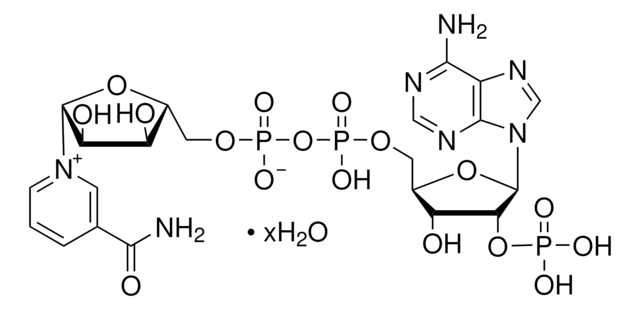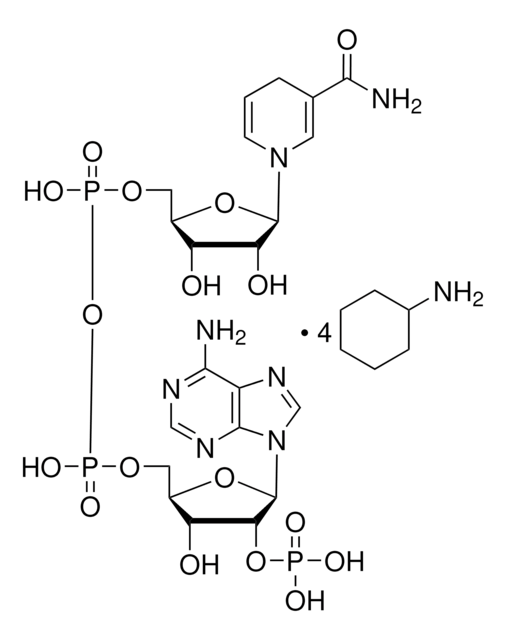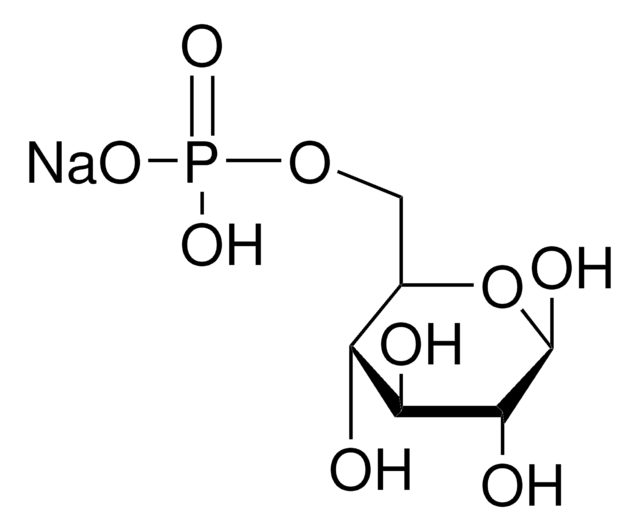Wszystkie zdjęcia(1)
Key Documents
F0628
Ferredoxin-NADP+ Reductase from Spinacia oleracea (spinach)
lyophilized powder, ≥15 units/mg solid, secondary activity: ≥10 units/mg solid NADPH diaphorase
Synonim(y):
Ferridoxin-NADP+ oxidoreductase
Zaloguj sięWyświetlanie cen organizacyjnych i kontraktowych
About This Item
Numer CAS:
Numer MDL:
Kod UNSPSC:
12352204
NACRES:
NA.54
Polecane produkty
Postać
lyophilized powder
Poziom jakości
aktywność właściwa
≥15 units/mg solid
obecność zanieczyszczeń
NADH diaphorase activity ≤10 units/mg solid
temp. przechowywania
−20°C
Opis ogólny
Ferredoxin-NADP+ Reductase is a ferredoxin-soluble partner with a molar ratio to PSI of 0.9 and 3.
Zastosowanie
Ferredoxin-NADP+ Reductase from Spinacia oleracea (spinach) has been used to test the effect of potential protein partners on the activity of the glyceraldehyde-3-phosphate dehydrogenase (GAPDH)−CP12 preparation. It has also been used in standard assay conditions for phycocyanobilin:ferredoxin oxidoreductase (PcyA) enzyme assay.
Ferredoxin-NADP+ Reductase was used in in vitro ferredoxin-dependent desaturation of fatty acids in cyanobacterial thylakoid membranes. It was also used to regulate glyceraldehyde-3-phosphate dehydrogenase.
Działania biochem./fizjol.
Ferredoxin-NADP+ reductase catalyzes the reversible conversion of reduced ferredoxin to oxidized ferredoxin during photosynthesis. Ferredoxin-NADP(H) reductase constitutes a family of hydrophilic FAD-containing monomeric enzymes that deliver NADPH or low potential one-electron donors to redox-based metabolisms in plastids, mitochondria, and bacteria.
Ferredoxin-NADP+ reductase catalyzes the reversible conversion of reduced ferredoxin to oxidized ferredoxin during photosynthesis. Ferredoxin-NADP(H) reductase constitutes a family of hydrophilic FAD-containing monomeric enzymes that deliver NADPH or low potential one-electron donors to redox-based metabolisms in plastids, mitochondria, and bacteria.
Definicja jednostki
One unit will reduce 1.0 millimole of cytochrome C per min at pH 7.5 at 25 °C in the presence of spinach ferredoxin and NADP.
This page may contain text that has been machine translated.
Kod klasy składowania
11 - Combustible Solids
Klasa zagrożenia wodnego (WGK)
WGK 3
Temperatura zapłonu (°F)
Not applicable
Temperatura zapłonu (°C)
Not applicable
Środki ochrony indywidualnej
Eyeshields, Gloves, type N95 (US)
Certyfikaty analizy (CoA)
Poszukaj Certyfikaty analizy (CoA), wpisując numer partii/serii produktów. Numery serii i partii można znaleźć na etykiecie produktu po słowach „seria” lub „partia”.
Masz już ten produkt?
Dokumenty związane z niedawno zakupionymi produktami zostały zamieszczone w Bibliotece dokumentów.
Klienci oglądali również te produkty
A Conserved Histidine-Aspartate Pair Is Required for Exovinyl Reduction of Biliverdin by a Cyanobacterial Phycocyanobilin:Ferredoxin Oxidoreductase
Tu SL, et al.
The Journal of Biological Chemistry, 281(6), 3127-3136 (2006)
Néstor Carrillo et al.
European journal of biochemistry, 270(9), 1900-1915 (2003-04-24)
Ferredoxin (flavodoxin)-NADP(H) reductases (FNR) are ubiquitous flavoenzymes that deliver NADPH or low potential one-electron donors (ferredoxin, flavodoxin) to redox-based metabolisms in plastids, mitochondria and bacteria. The plant-type reductase is also the basic prototype for one of the major families of
Glyceraldehyde-3-phosphate dehydrogenase is regulated by ferredoxin-NADP reductase in the diatom Asterionella formosa
Mekhalfi M, et al.
The New phytologist, 203, 414-423 (2014)
Ferredoxin-NADP+ Reductase KINETICS OF ELECTRON TRANSFER, TRANSIENT INTERMEDIATES, AND CATALYTIC ACTIVITIES STUDIED BY FLASH-ABSORPTION SPECTROSCOPY WITH ISOLATED PHOTOSYSTEM I AND FERREDOXIN
Cassan N, et al.
The Journal of Biological Chemistry, 280(28), 25960-25972 (2005)
Min Seok Cho et al.
Journal of microbiology (Seoul, Korea), 50(3), 496-501 (2012-07-04)
The Gram-positive bacterium Clavibacter michiganensis subsp. michiganensis is the causal agent of canker disease in tomato. Because it is very important to control newly introduced inoculum sources from commercial materials, the specific detection of this pathogen in seeds and seedlings
Protokoły
Enzymatic Assay of Ferredoxin NADP Reductase (EC 1.18.12)
Nasz zespół naukowców ma doświadczenie we wszystkich obszarach badań, w tym w naukach przyrodniczych, materiałoznawstwie, syntezie chemicznej, chromatografii, analityce i wielu innych dziedzinach.
Skontaktuj się z zespołem ds. pomocy technicznej












